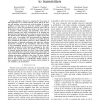Free Online Productivity Tools
i2Speak
i2Symbol
i2OCR
iTex2Img
iWeb2Print
iWeb2Shot
i2Type
iPdf2Split
iPdf2Merge
i2Bopomofo
i2Arabic
i2Style
i2Image
i2PDF
iLatex2Rtf
Sci2ools
INFOCOM
2010
IEEE
2010
IEEE
Neighbor Discovery with Reception Status Feedback to Transmitters
—Neighbor discovery is essential for the process of self-organization of a wireless network, where almost all routing and medium access protocols need knowledge of one-hop neighbors. In this paper we study the problem of neighbor discovery in a static and synchronous network, where time is divided into slots, each of duration equal to the time required to transmit a hello message, and potentially, some sort of feedback message. Our main contributions lie in detailing the physical layer mechanism for how nodes in receive mode detect the channel status, describing algorithms at higher layers that exploit such a knowledge, and characterizing the significant gain obtained. In particular, we describe one possible physical layer architecture that allows receivers to detect collisions, and then introduce a feedback mechanism that makes the collision information available to the transmitters. This allows nodes to stop transmitting packets as soon as they learn about the successful reception...
| Added | 28 Jan 2011 |
| Updated | 28 Jan 2011 |
| Type | Journal |
| Year | 2010 |
| Where | INFOCOM |
| Authors | Ramin Khalili, Dennis Goeckel, Donald F. Towsley, Ananthram Swami |
Comments (0)

